Last updated on September 17th, 2023
Claude Monet’s gardens and home in Giverny, France, offer a peek into the famous Impressionist painter’s world.
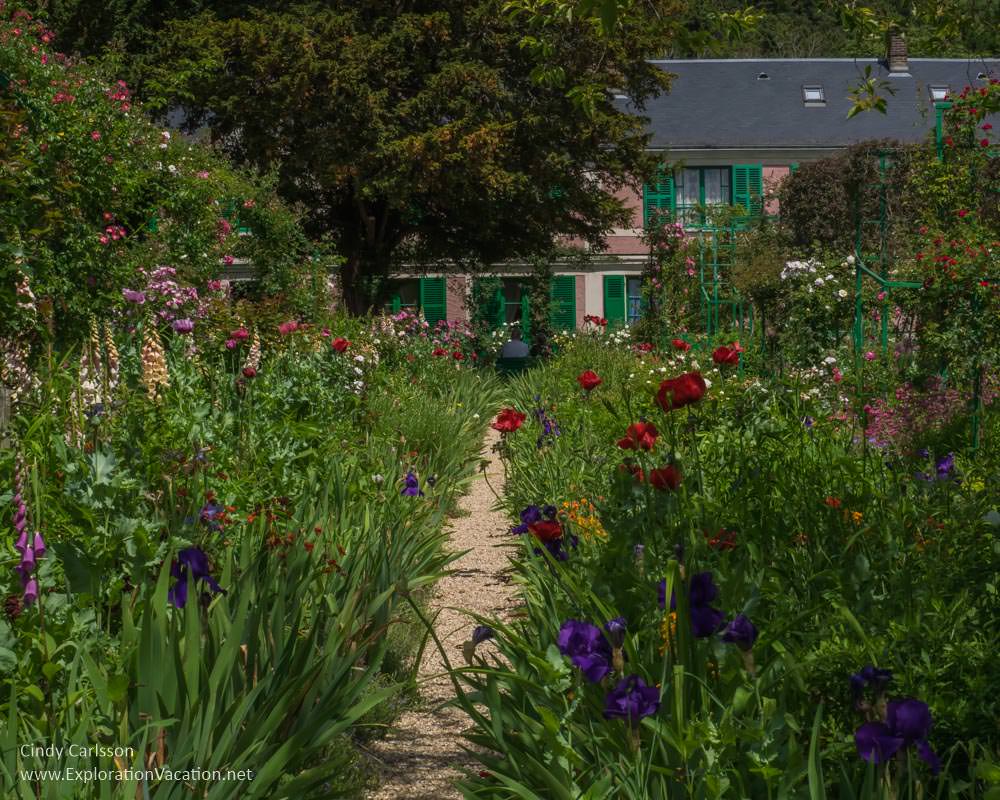
Some links in this post may be affiliate links that pay me a small commission if you use them to reserve a room, rent a car, or purchase goods or services. You don’t pay anything extra, but it helps keep this website running. To learn more, review this website’s policies and disclosures.
Wandering Monet’s gardens and home in Giverny
Painter Claude Monet moved to the village of Giverny in the French countryside in 1883.
He lived and worked there for the next 43 years, transforming an apple orchard and stream into the exuberant landscapes that became the central themes of his painting for the last decades of his life. Visiting Monet’s gardens and home today is an opportunity to step into the world captured in his paintings.
In Monet’s gardens
Monet created two distinct gardens:
- The Clos Normand where rectangular flowerbeds are interspersed with flowering trees, shrubs, and metal arches thick with climbing roses
- The water garden with its Japanese bridge, wisteria, and waterlilies
Monet is most famous for his large paintings of his water garden, but he loved and painted both gardens.
The Clos Normand
When Claude Monet first moved to Giverny, the house had an enclosed apple orchard and kitchen garden in back. This type of walled yard is known as a Clos Normand or Norman enclosure. It’s a practical design that keeps rabbits and deer from the vegetables and fruit trees.
However, one of Monet’s first projects was to lower the walls and remove a double row of cypress and spruce trees. This created a far more expansive space.
He then began his lifelong work of creating the garden itself. Metal arches for climbing roses replaced the spruce trees. Cherry and apricot trees replaced the apples. The ground was dug up and planted with thousands of flowers, some planted in big blocks of color like the colors on a painter’s palette, others arranged to form pleasing mounds of intermixed color and shape throughout the year.

The water garden
Ten years after arriving in Giverny, Monet purchased a piece of property adjoining his garden across the railroad tracks.
Almost immediately he diverted a small stream on the property to create a pond, which he then filled with water lilies. That first pond was small, with a Japanese-style bridge and just a few waterlilies. Over time, the pond was enlarged and reshaped. Additional water lilies were added and the surrounding landscape planted to create shady groves of bamboo, willow, and rhododendron.
The water garden became Monet’s favorite place both to paint and entertain guests. His paintings of the water lilies, wisteria-covered bridge, and the shimmering reflections they created are among his most famous works.
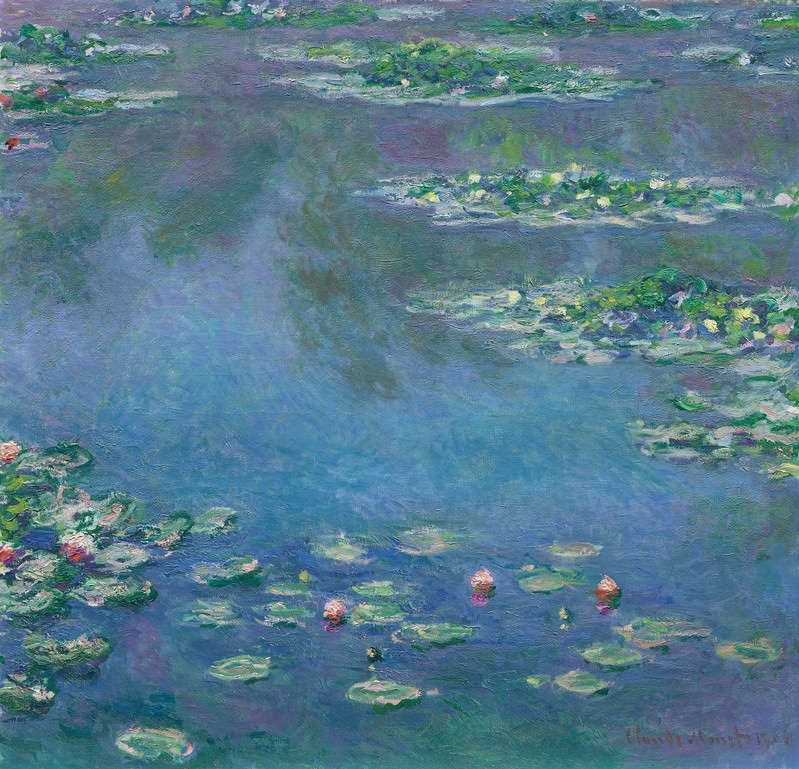
Water Lilies, Claude Monet, oil on canvas, 1906. Photo from the Art Institute of Chicago.
Inside Monet’s home
Despite its size, Claude Monet’s home is nearly hidden from view behind vines and the lush plantings of the Clos Normand.
From the outside, the house is a long, narrow confection of pink walls, white lace curtains, and bright green doors, shutters, and vines.
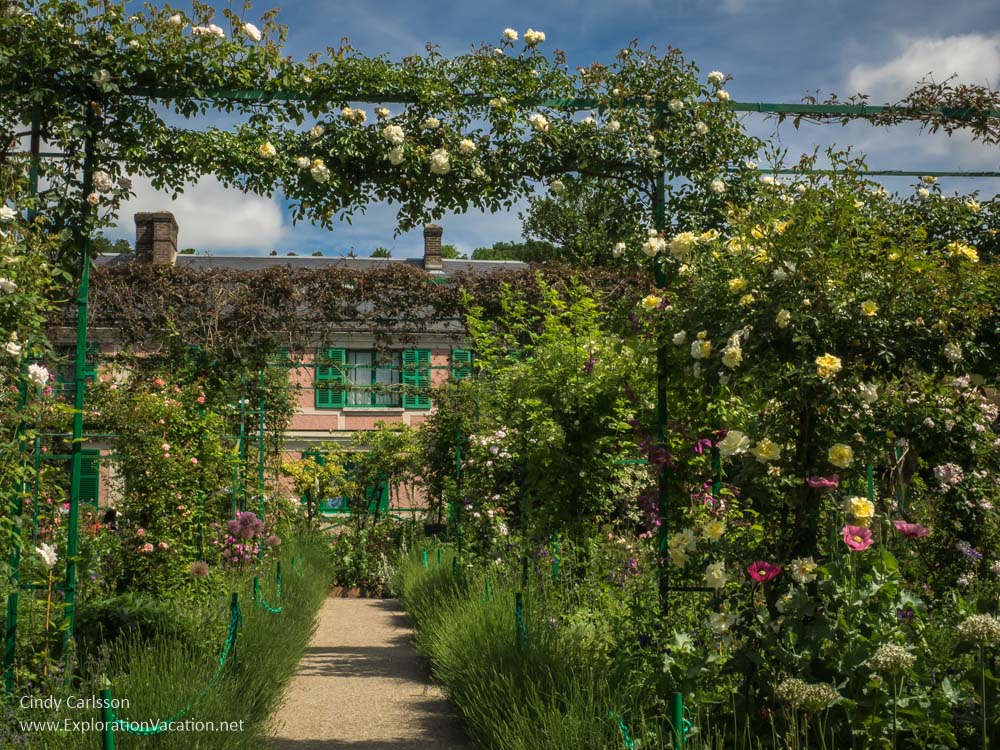

It is equally bright and colorful inside.
But the house hasn’t always been so large or so colorful.
When Monet moved here in 1883, the farmhouse was large, but much smaller than what we see today. Monet had a large family and many visitors; like the gardens, he expanded his house over time to meet his needs.
Monet’s first studio
When touring the house, the first of Monet’s three studios is one of the first – and most crowded – rooms visitors see.
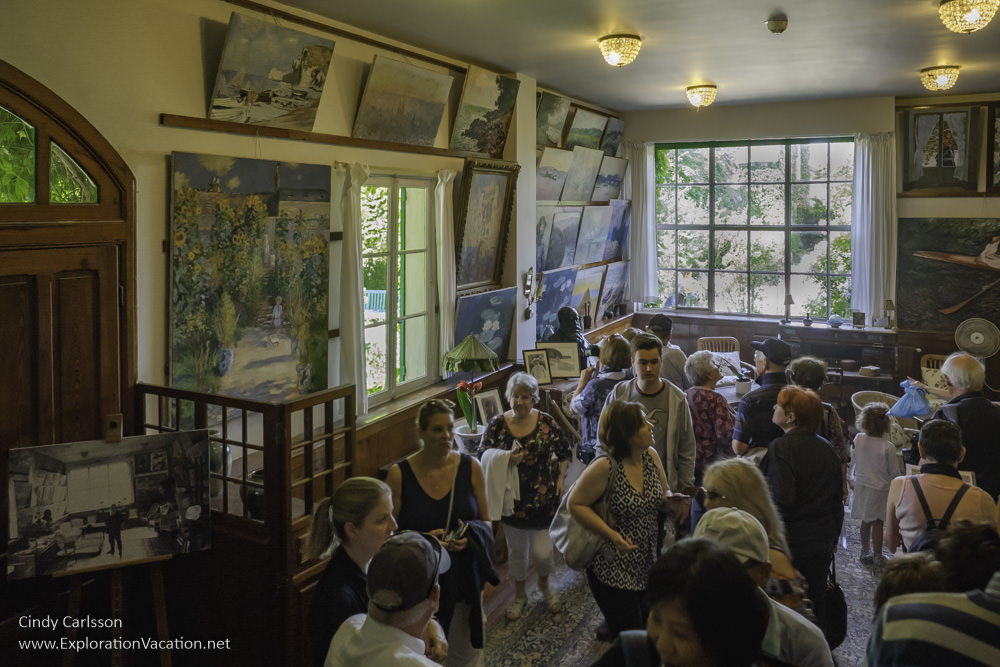
This end of the house was once a barn. Soon after moving to Giverny, Monet put a wood floor in the barn, added a stairway, and connected it to the house as his studio. He also turned the second floor into the bedroom that he used for the rest of his life.
By 1900 Monet was working in a new studio on the northern side of the building (still later he would build a third studio with a glass roof). It was then that this room became what we see today: a combination reception room, office, and salon where he could relax with family, entertain visitors, and meet with art dealers and collectors.
Monet always kept his favorite work from different periods on display here. Today the paintings here are reproductions. (The originals are at the Marmottan-Monet Museum in Paris.)
A magical world restored
To walk through the house and gardens at Giverny today is to feel as if Monet has just stepped out for a moment and could return at any time.
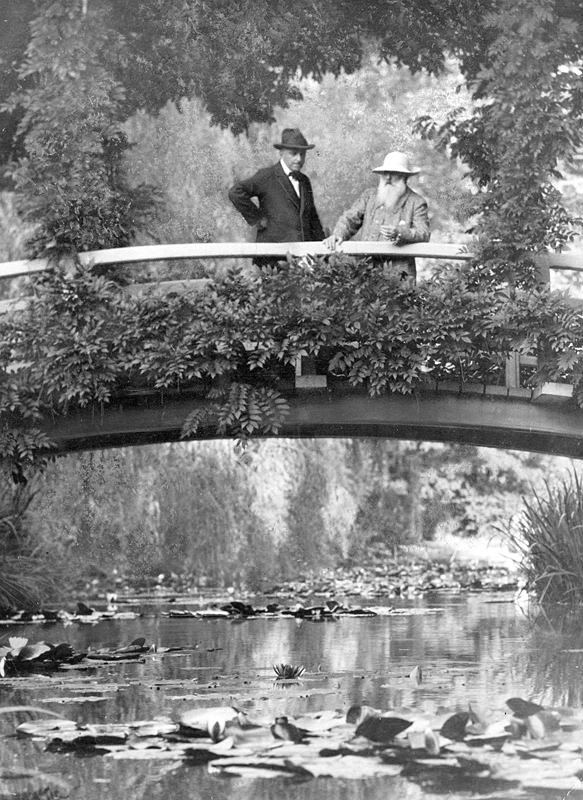
An image of Claude Monet in his garden in Giverny with an unidentified visitor. From The New York Times photo archive, dated only 1922, author not given (the image presumably in a Times December 24, 1922 profile on the painter). Photo via Wikimedia Commons.
However, almost everything at Giverny today has been painstakingly restored or completely re-created.
Plan a trip to Monet’s gardens and more in Giverny
Monet’s home, gardens, and supporting facilities are owned by the French Academy of Fine Arts (Académie des Beaux-Arts) and operated by its Claude Monet Foundation. The site includes Monet’s home and gardens, a gift shop, and restaurant. There is also an art museum (featuring artists other than Monet) that is owned by a different entity, but operated in conjunction with the Monet property.
Getting there
The charming village of Giverny, France, is about 75 miles northwest of Paris. It’s a few miles from the city of Vernon and is surrounded by beautiful countryside.
Private automobile
It takes a little over an hour to drive to Giverny from Paris, depending on the route and starting point.
While a car isn’t really necessary for a day trip to Giverny, it is needed to explore the surrounding area.
Rental cars are not available near the Vernon-Giverny train station, but can be rented elsewhere in Vernon and at some other train stations along the route.
Transit
The train between Paris and Rouen stops near Giverny.
Trains begin at the Saint Lazare Paris station, with the fastest arriving at the Vernon-Giverny station in about 45 minutes. Once there, a bus, shuttle, or taxi can take you to Monet’s garden. Bicycles are also available nearby. And, of course, you can always walk. (It takes about an hour to walk the 4 ½ miles between the station and the gardens.)
Tours
While it is quite easy to travel to Giverny on your own, there are many Giverny tours available from Paris. Tours will be for either a full or half day and may or may not include other attractions. Costs and quality appear to vary wildly.
Hours and seasons
Monet’s gardens in Giverny are a seasonal attraction!
The site – including the ticket booth – is open from 9:30 a.m. to 6:00 p.m. daily from late March through late October. Check the Monet Foundation website for exact dates.
The entire site closes for the winter.
Visiting Giverny
Crowds
Monet’s home and garden is always busy, although the largest crowds will be in spring and summer.
The shortest ticket line is generally first thing in the morning (before 10 a.m.) and then later in the afternoon. However, it’s best to skip the ticket line entirely by buying your ticket online in advance.
Guidebooks suggest that mid-day (over lunch) or later in the afternoon are the least-crowded times to visit. We were the first in line at the ticket booth at 9 a.m. and entered as soon as everything opened at 9:30. It was busy, but the Clos Normand wasn’t terribly busy. (The house and water garden were packed, as that seems to be where the tour groups start.) By noon most people seemed to have disappeared for the day, although there were still more people in the water garden than I would have liked!
A ticket to the site allows you to visit at your own pace and stay as long as you want. We spent about four hours and made a second visit to the water garden over lunch when the tour groups were gone.
Rules
In Monet’s time the entire garden would have been accessible to visitors. When the gardens were restored, some paths were made wider to allow public access to the garden. Only those paths are open to visitors today.
Stay on the path and do NOT pick the flowers. (Yes, I saw someone pick a poppy because she wanted the seeds – which, of course, it will not produce because she picked it while it was in bloom and long before it produced seeds.)
Pets are not allowed anywhere on the property.
What to expect in the gardens
Expect the garden to change with the season
This is a real garden and gardens change throughout the year. Tulips give way to peonies that give way to lilies and then mums.
If there is a particular type of flower you want to see, you need to time your visit accordingly and hope the weather has been normal. (The Monet Foundation website provides a general list of what is in bloom when as a PDF among other information on the plants.) But really, there will always be something in bloom because the gardeners are always removing spent plants and adding new ones.
Expect to see people working in the garden
Gardens are always a lot of work, but a garden where annuals are regularly swapped out requires even more work . . . and workers to do it. There are likely always a few people working in the garden. That’s just part of keeping the garden looking good.
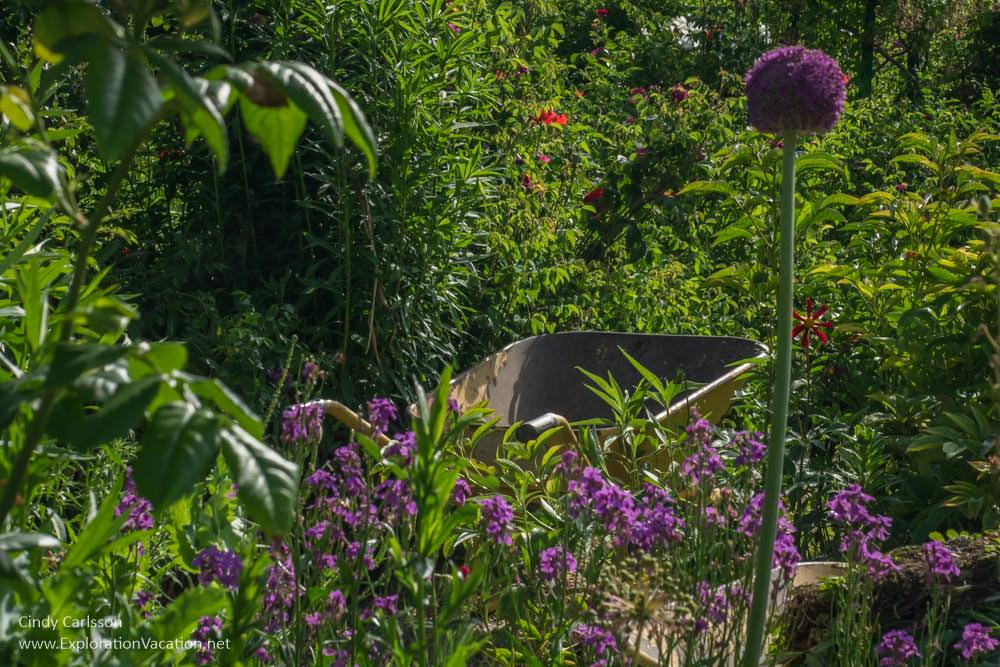
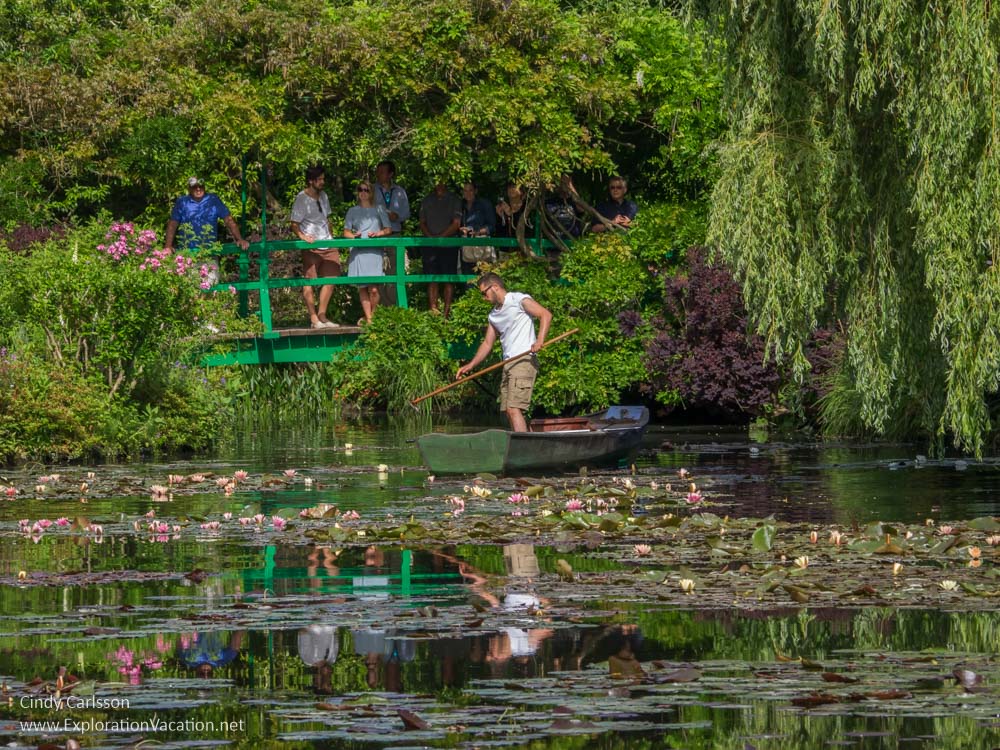
Don’t miss the water garden
Keep in mind that the water garden is reached via a tunnel under the roadway. The tunnel is located at the back corner of the Clos Normand, near an entrance for tour groups. There are signs to direct you there.
What to expect in the house
By the time he was finished expanding his house, Monet had a home that was a little more than 16 feet across and 130 feet long. That means it is mostly one-room deep, making it very congested for tourists!
Although it appears you can go one of two directions when you enter, DO NOT go up the stairs. Instead, turn and walk through the pantry to Monet’s studio/salon. (This is the biggest room in the house, but also the most crowded.) From the salon, go back through the pantry. Now go up the stairs. Once upstairs, there is only one route to take. Eventually you’ll come back down a second stairway.
Staying in Giverny
Although still an agricultural area, Giverny today is largely a tourist town with cute shops, loads of art galleries, and lots of small, up-scale accommodations. It’s an absolutely charming place to wander and makes a good base for a couple of pleasant days exploring the town and the surrounding area.
Lodging in Giverny
Lodging in the city is often booked-up far in advance during peak bloom times. Plan as far ahead as possible for the best selection and price.
While there is not a lot of moderate-priced lodging, there is some. We stayed near Monet’s family church at the family-run Le Coin Des Artistes. It was a short walk from the gardens and had easy on-street parking if you didn’t arrive in the middle of the day. It wasn’t fancy, but our room was clean and sunny with a nice view of the street.
To find a hotel, inn, or bed and breakfast in or near Giverny, check reviews, compare prices, and book a room through TripAdvisor, Hotels.com, Booking.com, or Expedia.
Airbnb also has a number of listings for Giverny and the surrounding area. If you haven’t tried Airbnb, this link can save you $40 on your first booking.
Dining in Givernay
There are a number of cafes that serve lunch, but truly wonderful restaurants, particularly for dinner, are in short supply. We ate dinner both nights at the Hotel Baudy’s restaurant, which was near our hotel and had a large outdoor terrace.
Be aware that most lunch-only cafes and restaurants stop serving by 1:30 or so. That probably explains why no one is in the gardens at that time of day! Eat a good breakfast, have a granola bar for lunch, then have a lovely early dinner.
Vernon
My guidebooks were all pretty dismissive of Vernon, but when we drove through town, it looked like there were a number of interesting, photogenic spots to stop. We wished we had left some time to explore the town. Consider giving yourself a bit of time there as well.
Resources
Giverny is a popular tourist site and lots of resources are available.
A couple of the most useful overall resources include:
- The Claude Monet Foundation operates the home, gardens, and museums. Their website has lots of information on for planning a trip to Giverny, although the English translations can be a bit odd. (The press kit PDF provides some of the best, most readable information on the house and gardens.) Advance tickets can also be purchased through their website.
- Giverny Village has a wealth of tourist information for the area, particularly for those interested in art and culture. The up-to-date news page is a great resource for tracking exhibits and events at the local galleries.
- org is a nonprofit web site written by locals (many of who seem to be or have been guides at Giverny) with a wealth of easy-to-digest information on Monet’s house and gardens, the village, and the surrounding area. Unfortunately not all sections are entirely up-to-date.
For visitors primarily interested in the gardens, websites worth checking include:
- Monet Foundation website provides a bit of information on plants in the garden and bloom season. Besides what is on the web page, there is a general list of what is in bloom (PDF)
- Giverny guide Ariane’s website Giverny Impression has posts that show changes in the garden throughout the year.
- Images of Monet’s gardens during his lifetime and later (in French) can be found in the gallery of Jean-Michel Peers on com.
The Art Institute of Chicago has an interpretive resource that examines Monet’s water landscapes.
Most visitors will probably be surprised to discover the Japanese print collection. Unfortunately, comprehensible English language information on this collection is a bit scarce. A few websites worth consulting include:
- A basic, easy to understand overview of Monet and Japanese Art from a 2008 exhibition is available on the Te Papa Tongarewa Museum of New Zealand
- An article on the Collection of Japanese pints of Claude Monet on the Giverny Village
- A very readable web page on Claude Monet’s Japanese print collection puts the collection and the influence of Japanese art on the Impressionists in perspective. However, there is no indication of the author’s authority – this could be a school project.




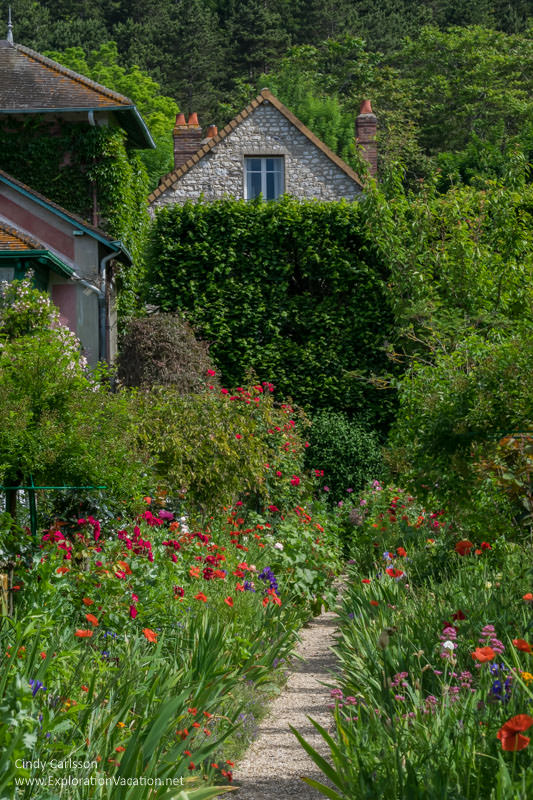





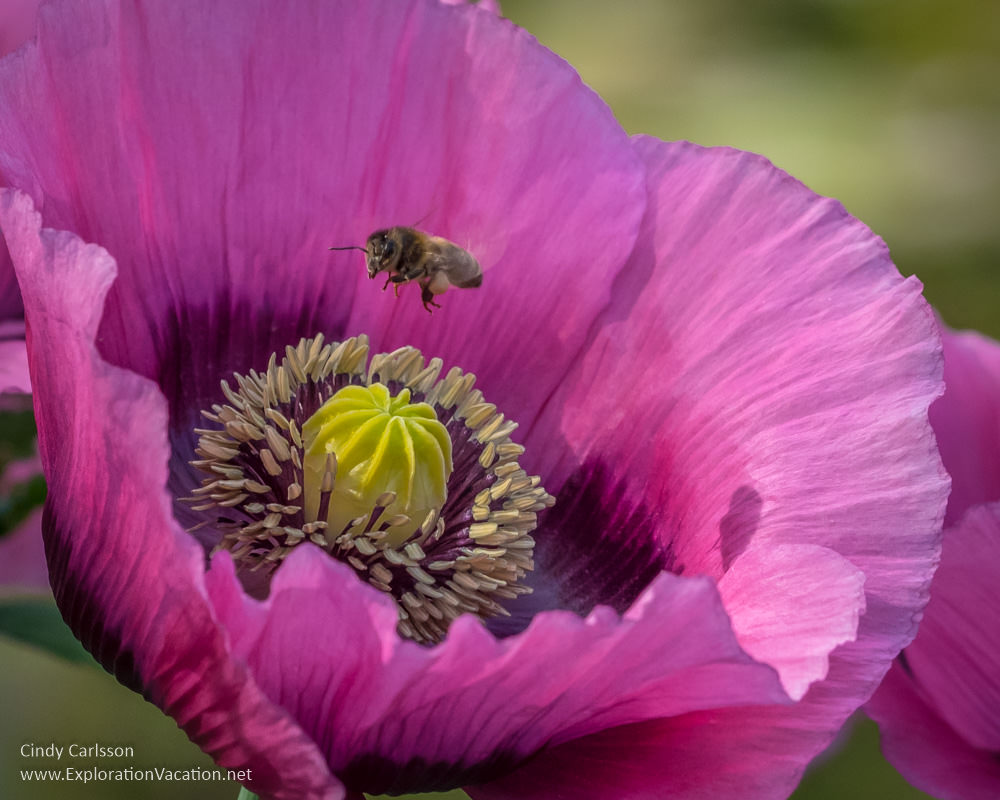


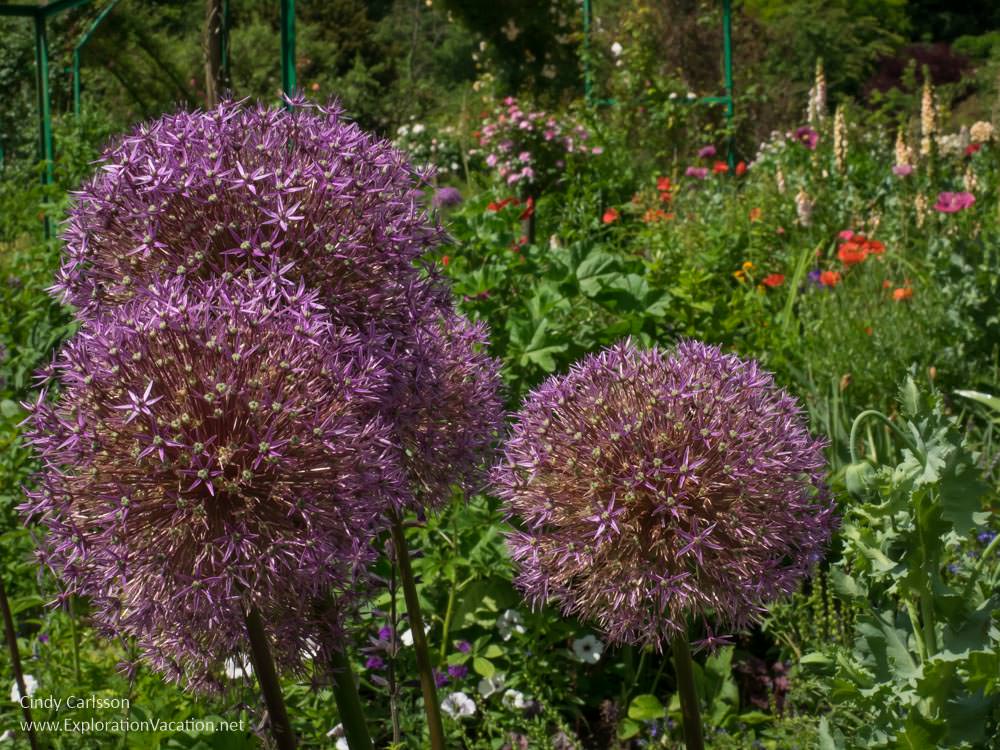
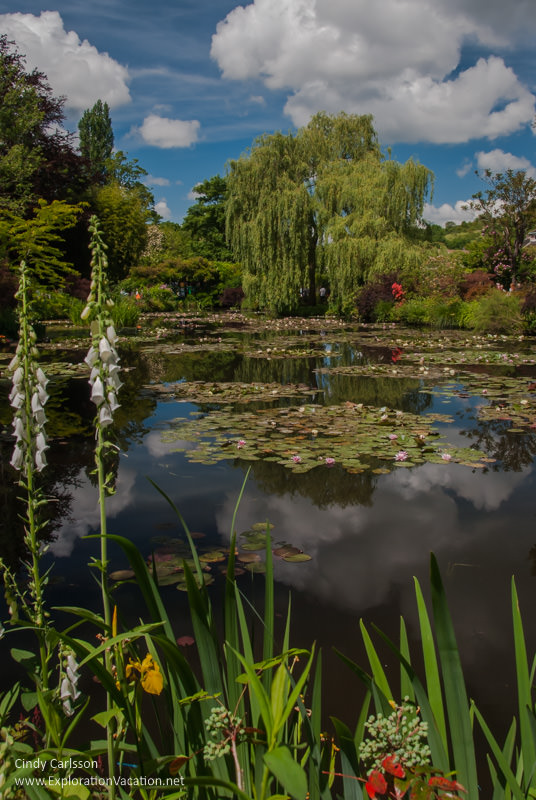


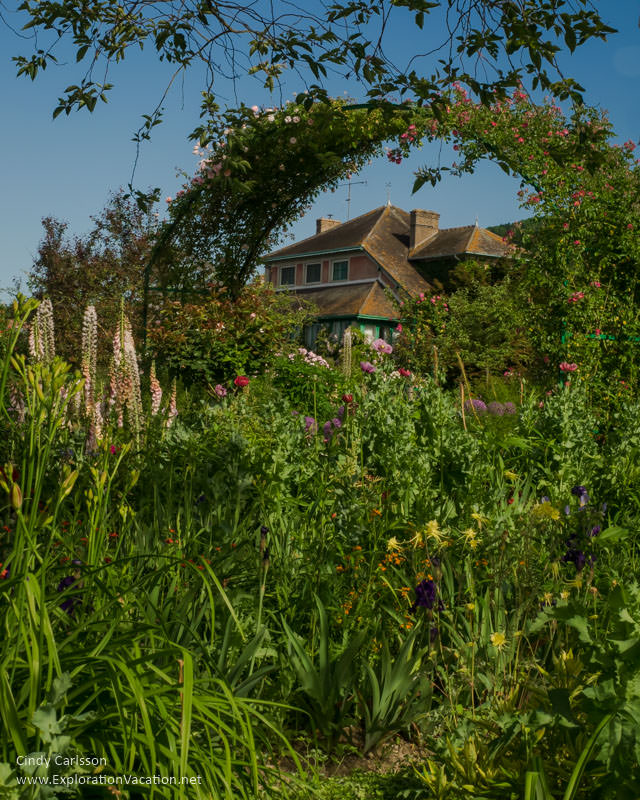

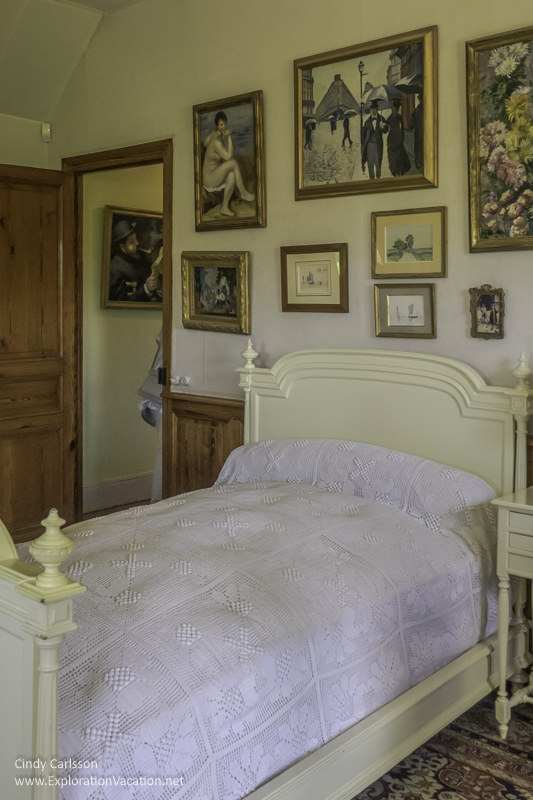
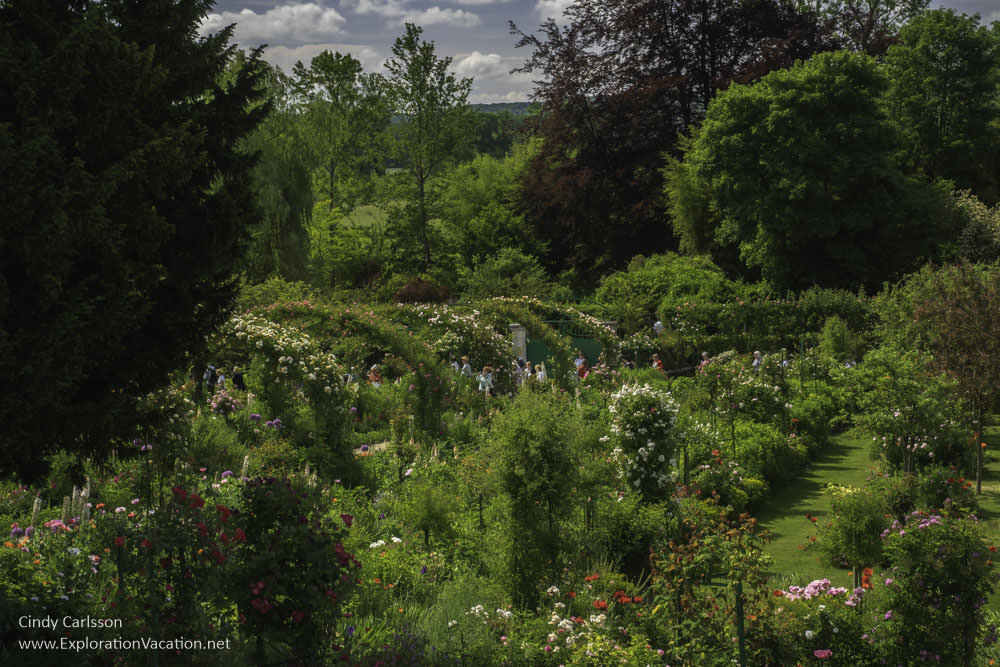

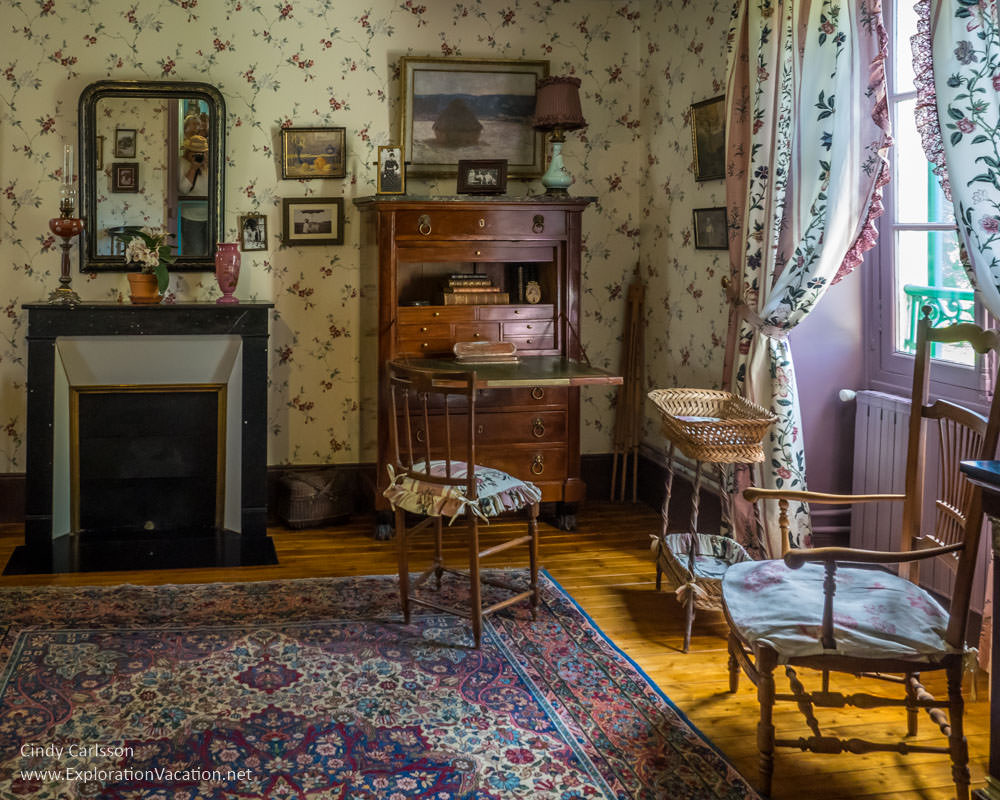
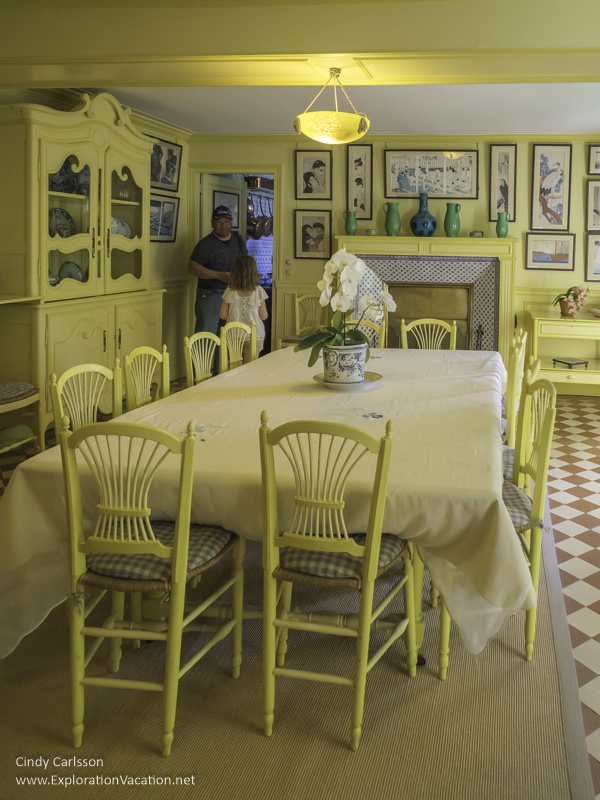
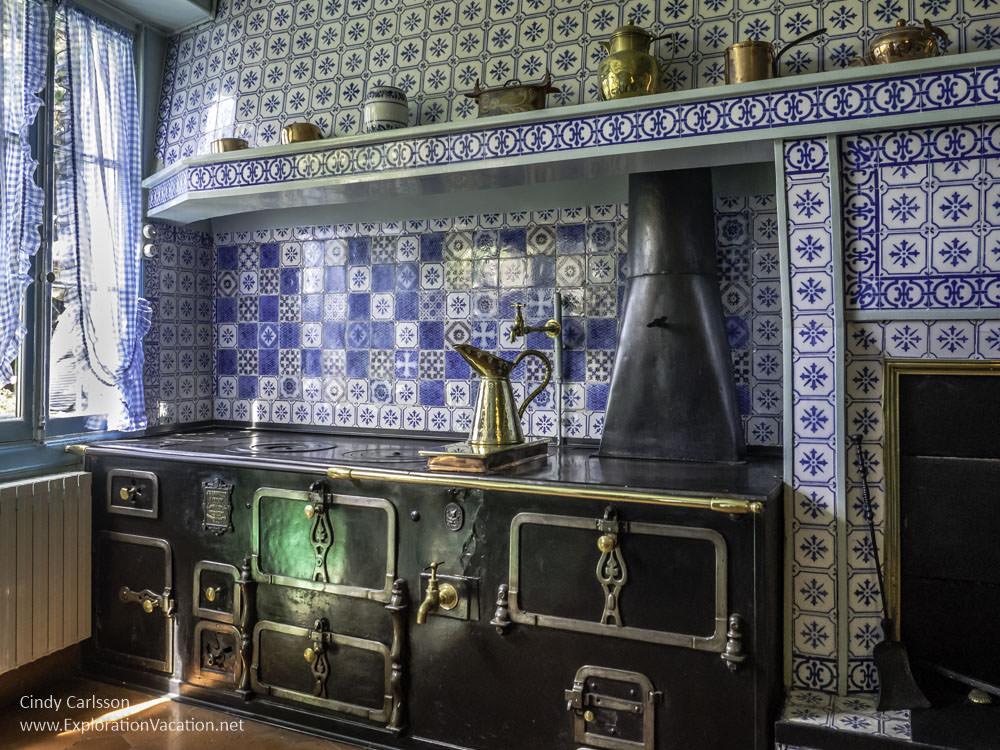
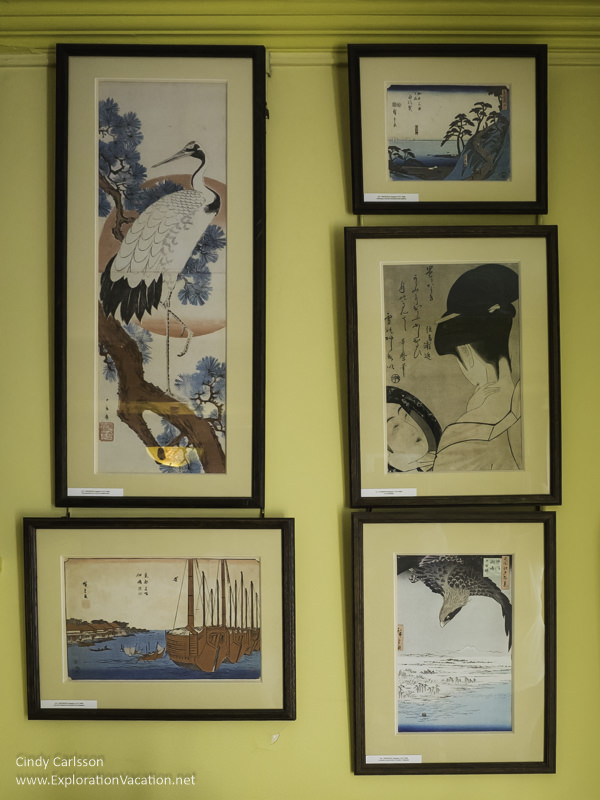
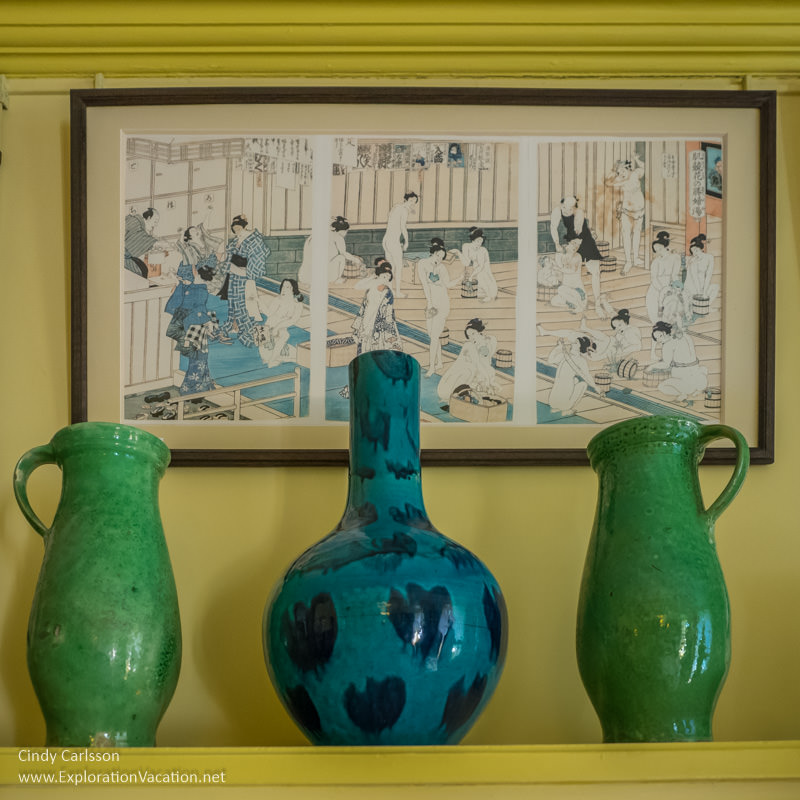



Those gardens are spectacular, and you’ve captured them beautifully with your photography! I love his kitchen tiles, and I’d take that copper pot collection too!
Thank you, Jessica. The kitchen was my favorite room too. I stayed in there quite a while! It’s all really beautiful. (And nothing dark and depressing!!)
If I had one more day during my trip to Paris, I would have spent it at Monet’s house in Giverny. Now that you’ve shown me what I missed, I yearn to return to France some day and go there. I’d love this house and garden, even if it wasn’t Monet’s. But Monet’s artistry is probably what makes it so remarkable to look at. I wish my garden looked like this, and I really like his yellow dining room chairs and the tiles in the kitchen.
It’s taken me a couple of trips to France to get here, but it is totally worth it. I too wish my gardens looked like this and still hope that someday they will look a little like this – once I win the lottery and can hire some gardeners to help me! I can use Monet as my guide. And yes, I’d also like a room full of those blue tiles! I hope you get there to see it all for yourself!
This post is just full of beauty. So many gorgeous scenes and well captured. I would love to go there one day. Thanks for linking up with Travel Photo Thurday.
Thank you. It really is a beautiful place. It’s also fascinating to walk through and see how it relates to Monet’s art. I hope you get there someday.
For those who really can’t tear themselves away from Paris, the Bagatelle is another great garden option. The gardens are larger and more varied than Monet’s, but, of course, they weren’t created by Monet!
I really like your detailed post. I do not get to see so much detail of this fantastic garden. I have not visited yet but hope to do it in the future. Love the photos featuring the water! #TPThursday
I hope you enjoyed your virtual visit, Ruth. And I hope you get there in person sometime too! Thanks for helping keep TPThursday going!
What a beautiful place! The gardens are stunning and of course the iconic water lilies are impressive. I love the blue and white tile in the kitchen too! We were hoping to make it there when we were in Paris a few years ago, but didn’t have the time. I’ll have to put this on my list for next time!
There’s so much to do in Paris that it’s always hard to justify leaving, but Giverny makes a nice day trip and the village is a nice change of pace from Paris. Of course, if you don’t want to wander too far, the gardens at the Bagatelle are even more impressive and much closer. (Although without the artist connection and not as simple to get to via transit.)
Very timely for us, Cindy, since we are planning a trip to Paris and northern France in early October. Tom just told me last night that he could “take or leave Giverny.” I’m betting your post will change his mind! Very lovely post! Thank you.
Oooh, a trip to France. That should be great. (It would be a great place to spend time on the water, as well as in gardens :-) We should get together — I’d love to hear your plans.